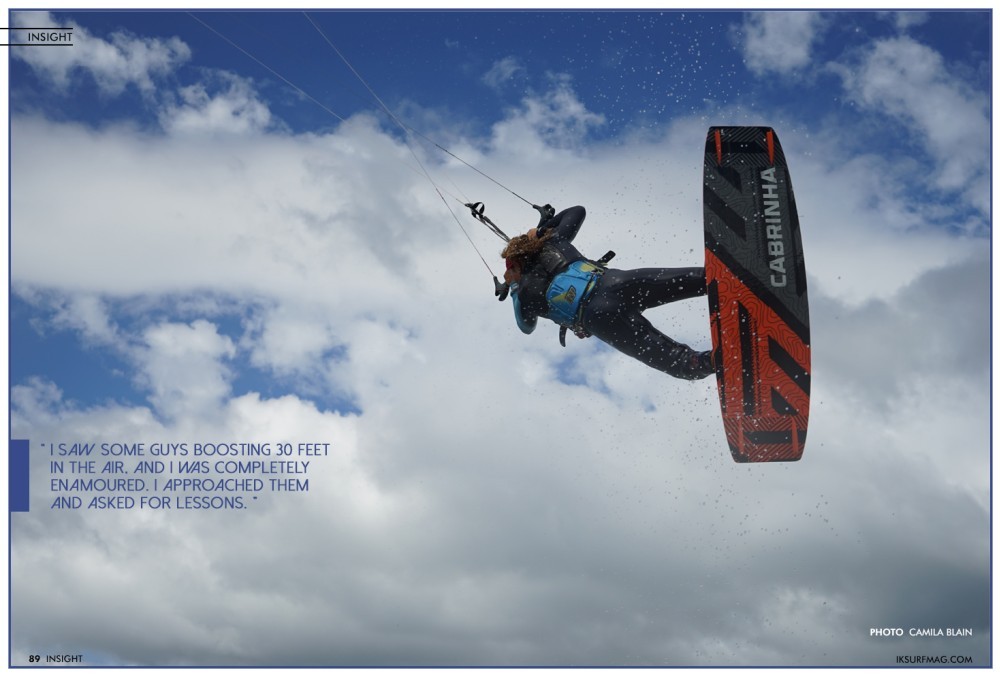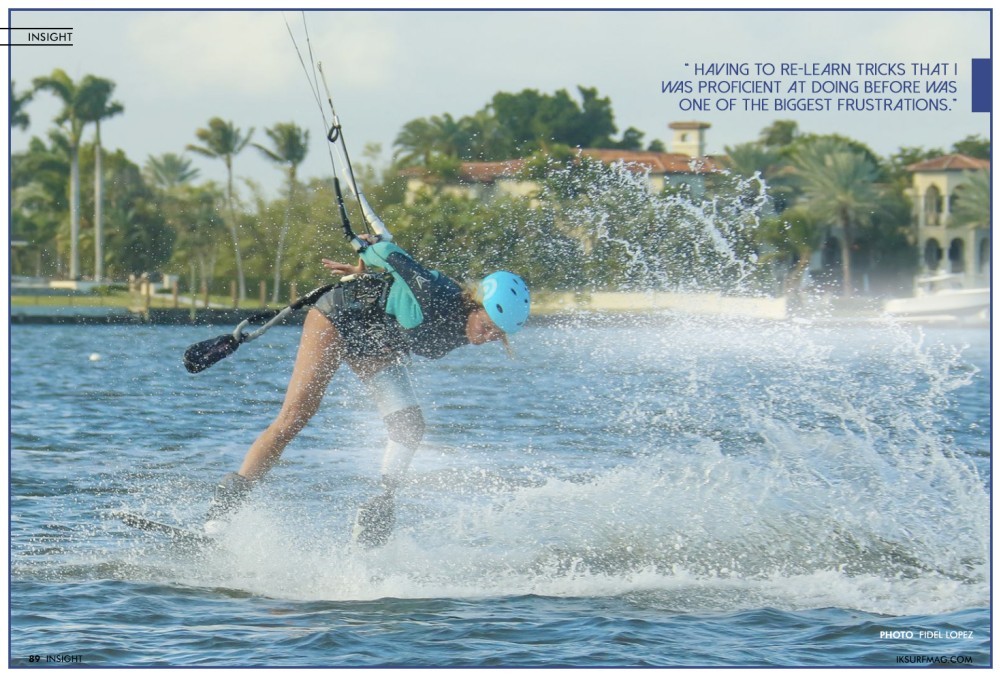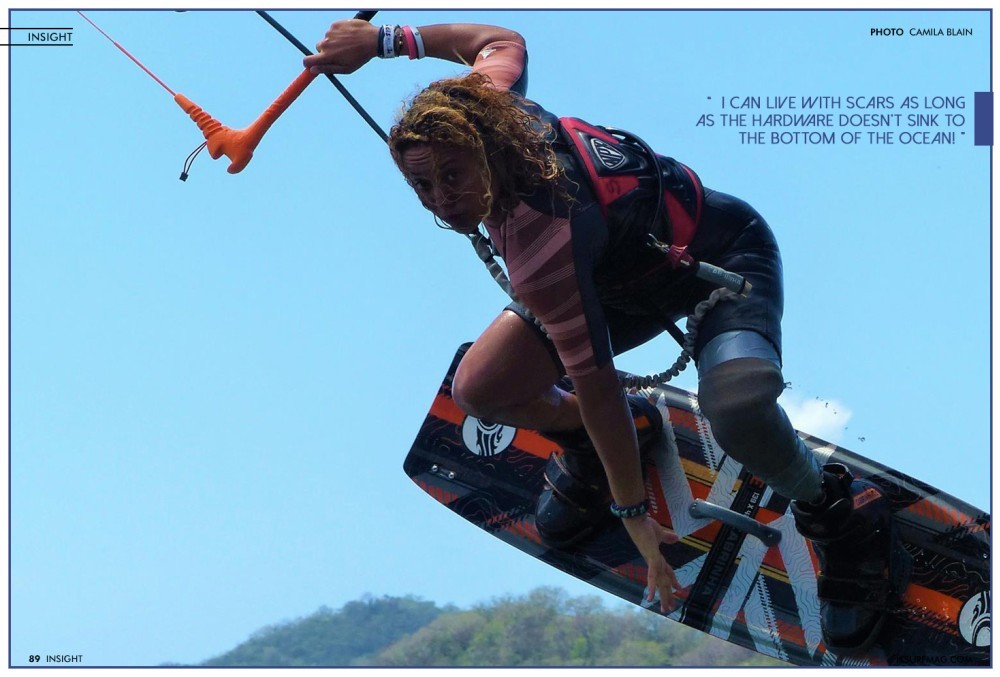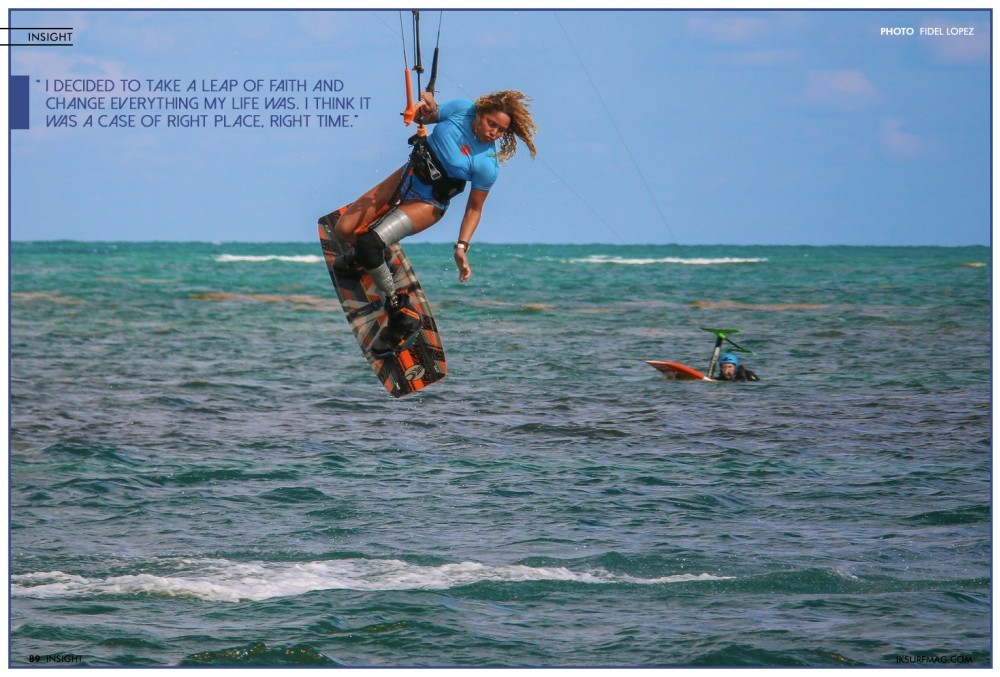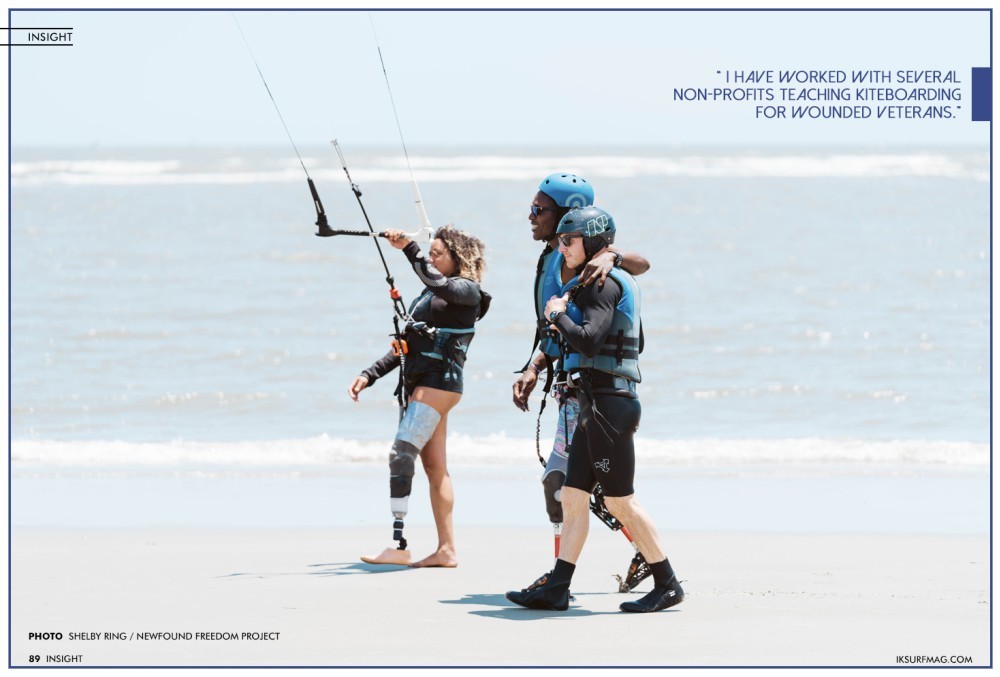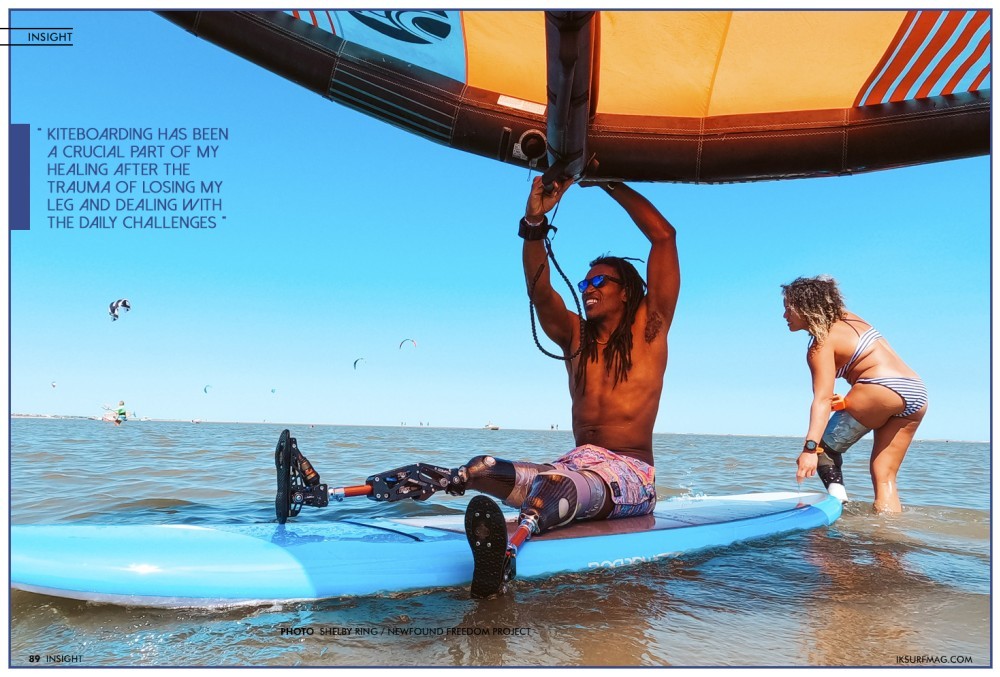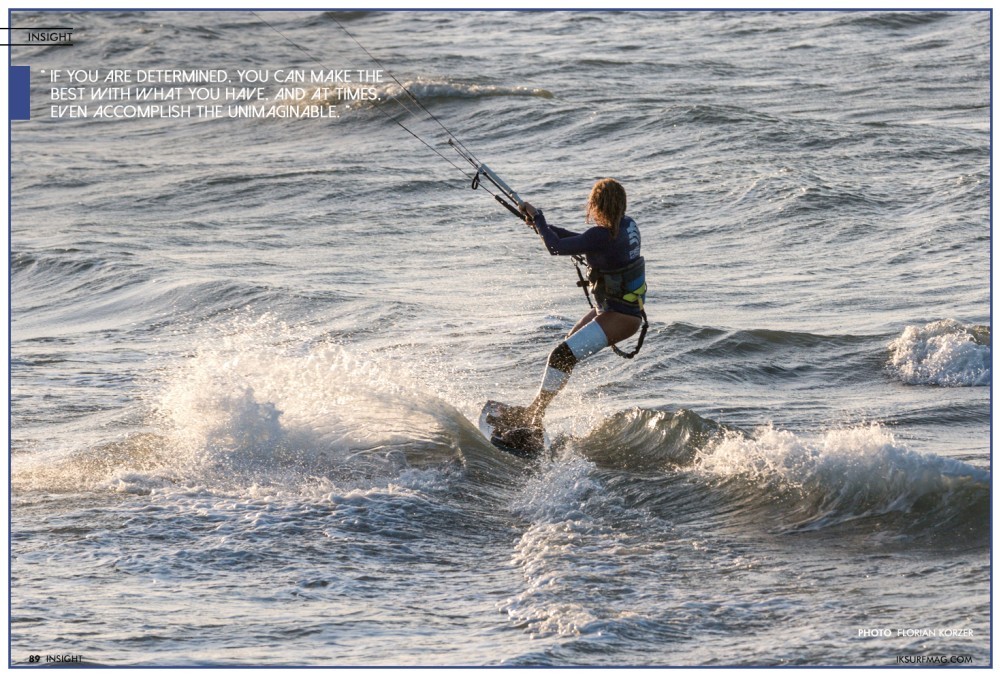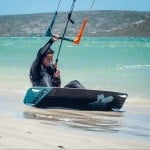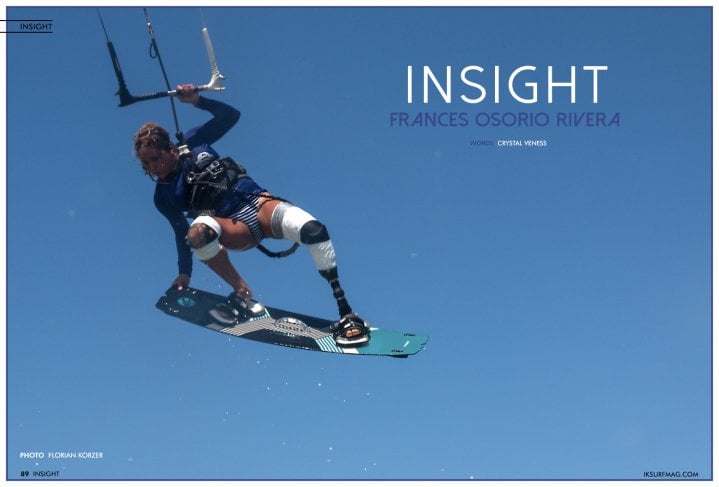
Insight: Frances Osorio Rivera
Issue 89 / Tue 5th Oct, 2021
In Insight, we highlight the inspiring women behind the scenes of kiteboarding. In this issue, we meet someone truly inspiring - Frances Osorio Rivera, an adaptive athlete working on the Cabrinha team. Learn all about Frances in this exclusive IKSURFMAG interview!
Frances, we are so excited to have you with us for Insight! But, first, tell us a bit about yourself! Do you come from a family of watersports lovers, or what inspired you to get into kiteboarding?
I was born and raised in the mountains of Puerto Rico in a city called Caguas. My grandfather and his brother in law loved to go fishing in the southwest side of Puerto Rico in Cabo Rojo. Besides that, I am the only watersports lover in the family.
After being forced to join the swimming team at age five and spending over ten hours/week swimming laps, my affection for watersports began. From there, I learned to first boogie board small waves and then surf and skateboard at the age of 16.
I started kiteboarding at the age of 19 after breaking all of the ligaments in my right ankle while skateboarding. I realised then that concrete is unforgiving, and there had to be a better alternative. Back then, in Puerto Rico, the scene was tiny. One day, while hanging out on the beach in Ocean Park, I saw some guys boosting 30 feet in the air, and I was completely enamoured. I approached them and asked for lessons. Four hours later, I was up and riding, although I didn't know how to go upwind, so there were many walks of shame!
Can you tell us a bit more about the accident that took your leg?
In 2011, I was in the Army and stationed in Jacksonville, NAS, when I got into a car accident, sustaining severe trauma to the left leg. After eight surgeries and a month in the hospital, they broke the news that I would lose my leg. It has been by far the most challenging circumstance I've had to go through in my life, as it is a daily challenge. A few months after the leg got amputated, I decided to give kiteboarding another go. However, the doctors in the hospital advised me to just "tone it down" and get involved with "less physically demanding sports". I remained in the Military service for another three years until 2014, when I got medically discharged due to the amputation.
What was it like trying to re-learn to kiteboard after the amputation?
At the time, it was a big challenge, and I had to re-learn it all. It took years to get past riding for 30-40 minutes per session, and I was mostly taking it day by day. Sometimes the leg is a pain quite literally, and some days things are more doable.
Having to re-learn tricks that I was proficient at doing before was one of the biggest frustrations. I take much longer than the average person to learn new tricks, and that can be quite the mental game even after a decade of being an amputee.
Over the years, I have lost several prosthetics; most were found within hours or days. One ended up being found by divers 3-4 years after I lost it in Puerto Rico. At that point, it was just a reef with shells and fish living on it. My friend Dagmar sent me a picture of it, and it was quite the emotional afternoon at Cabrinha's HQ.
Has your prosthetic been specially adapted for watersports?
My prosthetic team at Advanced Motion Control / Arthur Finnieston produced two legs for me. One looks like a C-blade that you usually see on runners and has a sole adapted to it to level the curvature of the blade so that it stays on the straps without much hassle. I like this one for riding with regular straps and doing boards offs.
The second prosthesis has a smaller C-shape where the ankle would be to have good impact absorption but is made to withstand salt and corrosion. The hardware of this one is made with stainless steel, and the shell is made of a composite material that gives some flex with impact. To finish both of them off, I use duct tape to secure the silicone sleeve, seal out water, and help prevent me from losing it. Sometimes the duct tape removes skin with it, but I can live with scars as long as the hardware doesn't sink to the bottom of the ocean!
Your kiting journey began in Puerto Rico, but nowadays, you're hanging your hat in Florida. How did that come about?
I began teaching kiteboarding in Puerto Rico in 2013 with a school called 15 knots, a Cabrinha centre and dealer. This was my introduction to Adventure Sports (back then, Pryde Group Americas). I occasionally would make a trip for leg purposes to Miami or come for a weekend and stop by to get gear for the school.
In 2015, I moved to Miami to become a "yachtie" and a few months later contacted Todd Greaux, who was Cabrinha's Sales Manager for the Americas at the time. I asked him for sponsorship, and he called back, offering me a job!
Six years later, I am still in Miami, loving life and South Florida.
What is your job title at Cabrinha now? What does the role involve?
My position in Cabrinha is Export Territory Manager. I take care of Central America, South America, and the Caribbean. I manage sales, demos, and I search for potential ambassadors, team riders, and clients.
What is your favourite part of the job? Do you get to spend as much time on the water as those dreaming of a kite industry job might assume?
The job allows you to connect with many individuals, including Cabrinha centres and dealers across the Americas. I hear their stories, create friendships, and have the opportunity to share the passion of the sport. Over the years, I have to say it has become more and more what people assume it is.
Under the new Cabrinha ownership, opportunities have arisen. There has been a shift to spending more time in the field with the dealers and the people, engaging all demographics to be a part of the sport and the Cabrinha family. However, it is still mostly a 9-5, Monday through Friday job grounded in the Headquarters in Miami. Unfortunately, I am not in the water seven days a week!
Did you ever think you would be working in the kite industry, apart from being a kite instructor? Or was this just a stroke of good luck?!
When I was 19, I was doing simple tricks and techniques on the water. Occasionally, I would think that it would be nice to have this as a job one day, and I would go about my days thinking it was just an unachievable dream. I was set on joining the Military and always thought it would be just a hobby that I would continue to have for years to come.
By the summer of 2015, I was medically discharged from the Army and was a recently single woman, and I decided to take a leap of faith and change everything my life was. I think it was a case of right place, right time. That call to Todd Greaux that ended with a job offer was a stroke of luck, but I also believe he saw my continuous years as a kite instructor that made him believe I would be a valuable addition to the team.
Do you have any advice for anyone out there who dreams of working in the kite world?
It's worth it. Even though it is a multi-million-dollar corporate industry, it is the least corporate job you'll ever have. Not everyone gets to say they make a living doing what they are passionate about, which most do as a hobby. Speaking from my experience with Cabrinha and Dakine, it has become a pretty tight family over the years.
You've got a lot of other stuff happening outside of the Territory Manager role at Cabrinha! What else keeps you busy?
Since starting with Cabrinha in 2015, I have worked with several non-profits teaching kiteboarding for wounded veterans. Cabrinha has always allowed me to do that as community outreach for the sport. It is now the 6th year that I've been involved with different groups, and it is something that gives me a sense of paying it forward after my time in the service.
These days, I am a board member of Veterans Adventure Group, a non-profit with multiple adventure-filled outdoor activities for veterans. I also am co-chair for the Woman's Kiteboarding Collective, and I seize every opportunity to advocate for adaptive sports. This year, I was part of the first two events with Newfound Freedom, a non-profit sponsored by Cabrinha.
Over the past couple of years, I have been doing documentaries and commercials. That includes a documentary that won the Toyota Viewer's Choice Award for the Miami Film Festival called Endure the Suck. More recently, a documentary for Visit Florida just aired called Limitless Florida. I've also been an adaptive model in a recent campaign for the Adidas website.
Tell us a bit more about the Newfound Freedom project. What is it all about?
The Newfound Freedom project is a fresh new 3-year collaboration between Cabrinha & Estuary Brewing. The project purpose is to introduce those who face unique challenges to watersports through a series of instructional days, led by some of Cabrinha's top athletes and staff.
You can learn more about Newfound Freedom and learn how to support this project by visiting the Cabrinha website: https://www.cabrinha.com/pages/newfound-freedom-project.
What was it like sharing your love for kiteboarding with the Newfound Freedom participants?
It meant everything to me. Kiteboarding has been a crucial part of my healing after the trauma of losing my leg and dealing with the daily challenges of having a permanent disability. I've always found joy in seeing others stoked about this sport. When you share that stoke with people that experience similar challenges to yourself, it can be as thrilling as the sport itself. Maybe they can find healing even if it is just the experience of doing it for a weekend.
Was there any particular moment or experience that stood out to you while working with the Cabrinha team on the Newfound Freedom project?
Some years back, I met a double amputee named Bradley Johnson through a mutual kiteboarding friend. He ended up being one of the coolest people I've met, and he gave me some solid advice on my physical and mental struggles. During the first Newfound Freedom event in Charleston, I saw the roster of participants, and the name struck me as odd, but I didn't place it at the time. Then, on the first night, I unexpectedly see this man, and I'm stunned. After all these years, here was this cool dude - with the most real advice on dealing with loss and letting go of the past - at this event, to learn how to kite.
If you hadn't taken up kiteboarding, where do you think you would be, and what would you be doing today?
Woah, that's a tough one! If I didn't take up kiteboarding, I would probably still be surfing or boogie boarding—at least a water-related hobby. I'm an island girl, and I need to be close to the water. But, who knows where I would be? I probably would have continued as a nurse, which is what I have a degree in.
You've been an absolute inspiration to everyone who has met you, especially those who have wondered if they had what it takes to learn a sport like kiteboarding. What motivates you to share your journey with others?
I guess my motivation and goal is to show that a disability doesn't limit what you can accomplish in life, although it sucks, takes longer, and is an endless mental and physical battle. But, if you are determined, you can make the best with what you have, and at times, even accomplish the unimaginable.
What's next for you?!
I am open to any opportunity for growth available out there. I want to show the world that there isn't a limit to what one can accomplish. There are opportunities out there even if you are missing a part of your body. Life can be beautiful, exciting, fun and filled with opportunities if you put yourself out there!
Thanks again for joining us today, Frances!
Videos
By Crystal Veness
Editor at IKSURFMAG, Crystal Veness hails from Canada but is based in South Africa. When she isn't busy kitesurfing or reporting on the latest industry news for the mag, she is kicking back somewhere at a windy kite beach or working on creative media projects.




